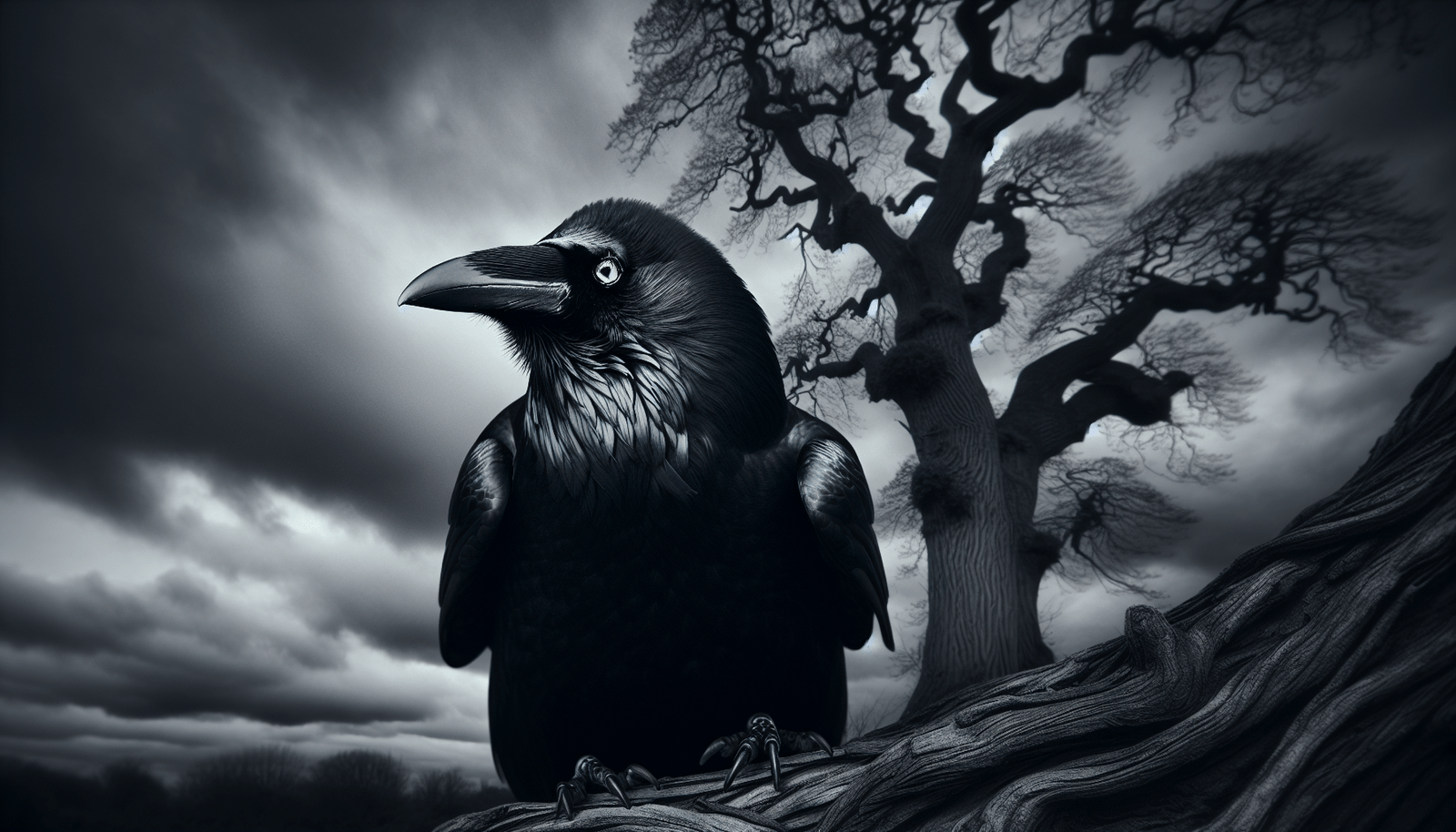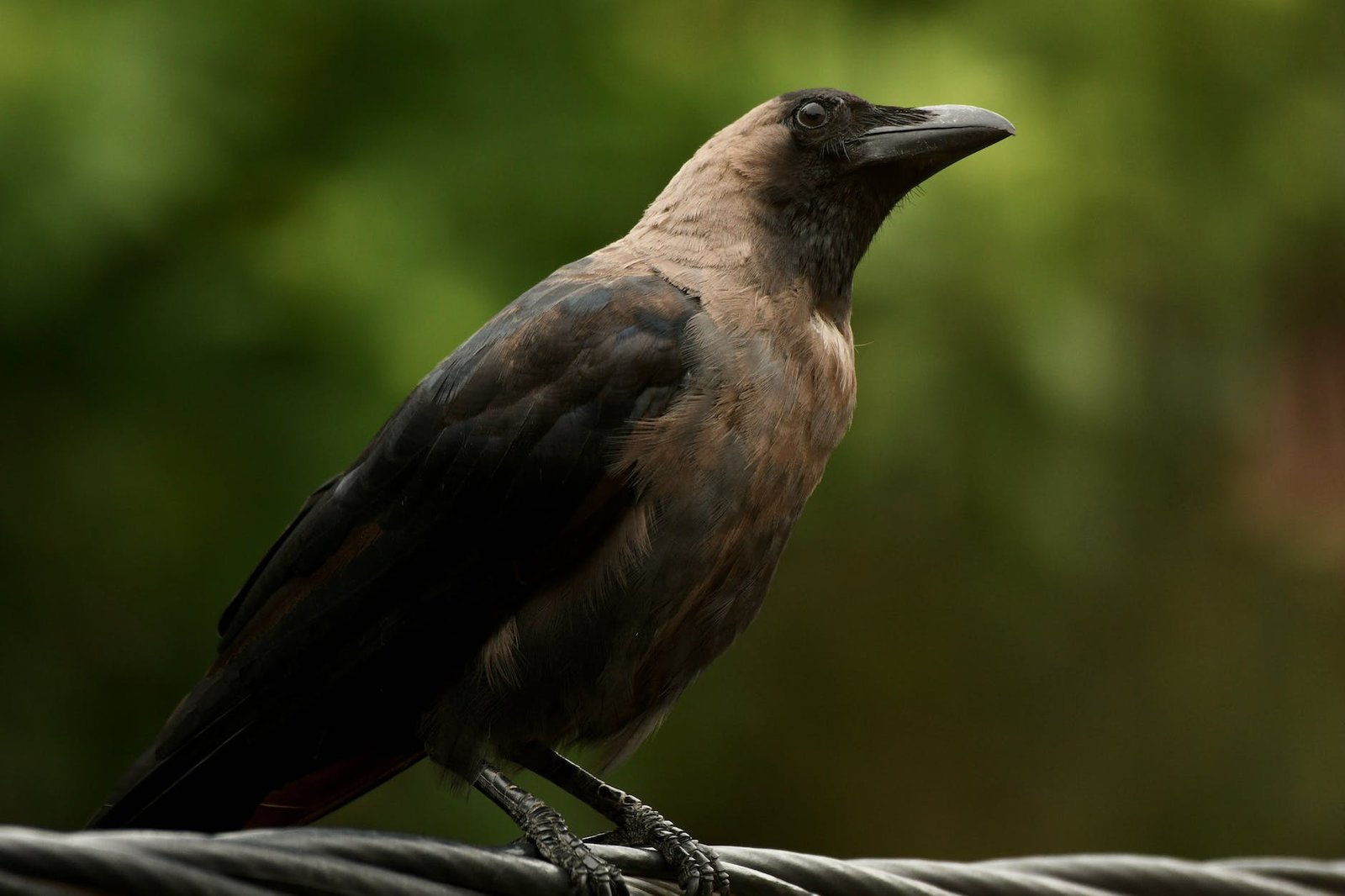Unearthing the Secrets: Corvus Woodfordi, The Solomon Islands Crow
December 30, 2023 | by BlackCrow.com

Introduction to Corvus Woodfordi
The Solomon Islands Crow, scientifically known as Corvus Woodfordi, is a fascinating bird species native to the southern Solomon Islands. Also referred to as the White-billed Crow, this crow species was first described by Ogilvie-Grant in 1887. Let’s take a closer look at this intriguing avian species.
Overview of the Solomon Islands Crow
The Solomon Islands Crow is a medium-sized bird that belongs to the Corvidae family, which includes other intelligent and sociable birds like ravens, crows, and jays. This species is known for its striking appearance and unique behaviors.
One distinguishing feature of the Solomon Islands Crow is its white bill, which contrasts with its glossy black feathers. The plumage of the bird is predominantly black, providing a sleek and elegant appearance. The crow’s beak has a slightly curved shape, allowing it to efficiently forage and manipulate objects in its environment.
These birds are highly adaptable and can thrive in various habitats, including forests, agricultural areas, and even urban environments. They are often found in small family groups or larger flocks, where they exhibit social behaviors and communicate through a range of vocalizations.
Taxonomic Information
Scientifically classified as Corvus Woodfordi, the Solomon Islands Crow belongs to the genus Corvus, which includes a diverse group of crow species found across the globe. Some related species include the Pied Crow (Corvus Albus), White-necked Raven (Corvus Albicollis), and American Crow (Corvus Brachyrhynchos).
Here is the taxonomic hierarchy of the Solomon Islands Crow:
- Kingdom: Animalia
- Phylum: Chordata
- Class: Aves
- Order: Passeriformes
- Family: Corvidae
- Genus: Corvus
- Species: Woodfordi
Understanding the taxonomic classification of the Solomon Islands Crow helps us place it within the broader context of avian diversity and evolutionary relationships.
As we delve deeper into the world of the Solomon Islands Crow, we will explore its physical characteristics, distribution, behavior, and conservation status. Stay tuned to learn more about this captivating bird species.
Physical Characteristics
The Solomon Islands Crow, scientifically known as Corvus Woodfordi, is a remarkable bird with distinct physical characteristics that set it apart. Understanding its appearance, coloration, size, and morphology provides valuable insights into this unique species.
Appearance and Coloration
The Solomon Islands Crow exhibits a striking appearance characterized by its sleek black feathers. The plumage of adult individuals is predominantly black, contributing to its captivating and elegant presence. The feathers have a glossy sheen, adding to the bird’s aesthetic appeal.
One notable feature of the Solomon Islands Crow is its white bill, which contrasts beautifully against the dark plumage. The white bill is a distinguishing characteristic of this species and contributes to its alternative name, the White-billed Crow. This distinct feature sets it apart from other crow species found in different regions, such as the Pied Crow or Cape Crow.
Size and Morphology
In terms of size, the Solomon Islands Crow is relatively small compared to other members of the crow family. The average length of an adult Solomon Islands Crow ranges between 38 to 40 centimeters (15 to 16 inches).
Like other crows, it possesses a robust and compact body with strong wings suitable for flying. Its wingspan typically measures around 80 to 90 centimeters (31 to 35 inches), allowing for agile movement and navigation in its habitat.
The species does not exhibit significant sexual dimorphism, meaning that males and females have similar physical characteristics. Both genders share the striking black plumage and white bill, making it challenging to differentiate between them based on appearance alone.
Understanding the physical characteristics of the Solomon Islands Crow not only provides an appreciation for its unique beauty but also assists in identifying and distinguishing it from other crow species.
Distribution and Habitat
The Solomon Islands Crow, scientifically known as Corvus woodfordi, is endemic to the Southern Solomon Islands in the Pacific Ocean. Let’s explore the range and preferred habitat of this fascinating bird.
Range of the Solomon Islands Crow
The Solomon Islands Crow is found exclusively within the Southern Solomon Islands, which include islands such as Guadalcanal, Malaita, Makira, and Santa Isabel. Its distribution is limited to these islands, and it is not found in any other regions of the world. This localized range makes the Solomon Islands Crow a unique and important species within its ecosystem.
Preferred Habitat
Within its range, the Solomon Islands Crow occupies a variety of habitats, including both lowland and montane forests. These forests are characterized by dense vegetation and a diverse array of tree species. The crow can be found in both primary forests, which are undisturbed and mature, as well as secondary forests that have undergone some degree of human or natural disturbance.
The Solomon Islands Crow is primarily a canopy-dwelling species, spending most of its time in the upper levels of the forest. It is well adapted to this arboreal lifestyle, using its strong wings and agile feet to navigate through the dense vegetation. The crow’s ability to thrive in different types of forests showcases its adaptability to a range of ecological conditions.
It is worth noting that the Solomon Islands Crow has a relatively small population size and is considered vulnerable to habitat loss and degradation. Conservation efforts are crucial to protect its preferred habitat and ensure the long-term survival of this unique bird species.
Understanding the range and habitat preferences of the Solomon Islands Crow provides valuable insights into its ecological niche and the conservation measures required to safeguard its population.
Behavior and Diet
Understanding the behavior and diet of the Solomon Islands Crow, also known as Corvus Woodfordi, provides insights into the fascinating lives of these birds.
Social Behavior
Solomon Islands Crows are highly social birds and are often found in small groups or pairs. They engage in various social behaviors, including cooperative breeding, where individuals within a group help raise the offspring of the dominant breeding pair. This cooperative behavior ensures the survival and success of the entire group.
These crows are known for their intelligence and problem-solving abilities. They have been observed using tools, such as sticks, to extract insects from tree bark or to access food sources. Their cognitive abilities and complex social interactions contribute to their adaptability and survival in their natural habitat.
Feeding Habits and Diet
The diet of the Solomon Islands Crow is diverse and adaptable. They are omnivorous birds, feeding on a wide range of food sources. Their diet primarily consists of fruits, seeds, insects, small vertebrates, and carrion. They are opportunistic feeders and have been observed scavenging for food in various habitats, including forested areas, agricultural fields, and coastal regions.
These crows are known to exhibit unique foraging behaviors. They have been observed using their beaks to probe into tree bark or leaf litter to find hidden prey. They also take advantage of human settlements, where they scavenge for food scraps and utilize urban environments to their advantage.
To maintain their health and meet their nutritional requirements, Solomon Islands Crows have developed a varied diet that allows them to adapt to different ecological niches within their range.
Understanding the behavior and diet of the Solomon Islands Crow provides a glimpse into the complex social dynamics and ecological interactions of these intelligent birds. By exploring their social behavior and feeding habits, we can appreciate the remarkable adaptations that enable them to thrive in their natural habitat.
Conservation Status
The conservation status of the Solomon Islands Crow, scientifically known as Corvus Woodfordi, is a matter of concern due to various threats to its population. Understanding these threats is crucial for implementing effective conservation measures and protecting this unique species.
Threats to the Solomon Islands Crow
The Solomon Islands Crow faces several threats that contribute to its vulnerable conservation status. These threats include:
-
Habitat Loss: Deforestation and habitat degradation pose significant challenges to the survival of the Solomon Islands Crow. The conversion of forests into agricultural land and logging activities reduce the availability of suitable habitats for the crow.
-
Invasive Species: The introduction of invasive species, such as rats and cats, has had a detrimental impact on the native bird populations in the Solomon Islands, including the crow. These invasive predators compete for resources and prey on the eggs and nestlings of the Solomon Islands Crow, leading to population decline.
-
Hunting and Collection: The hunting and collection of the Solomon Islands Crow for its feathers, eggs, or as pets are additional factors contributing to the decline of its population. Unsustainable hunting practices can further exacerbate the vulnerability of this species.
Conservation Efforts
Efforts are being made to conserve and protect the Solomon Islands Crow in order to mitigate the threats it faces. Some of the conservation initiatives include:
-
Protected Areas: Establishing protected areas, such as national parks and reserves, helps to safeguard the remaining habitats of the Solomon Islands Crow. These protected areas provide a safe haven for the birds and support their breeding and foraging activities.
-
Habitat Restoration: Restoration projects aim to restore degraded habitats by replanting native vegetation and creating suitable nesting sites for the Solomon Islands Crow. These efforts help improve the availability of resources for the bird and promote its population recovery.
-
Community Engagement: Engaging with local communities is crucial for the success of conservation efforts. Raising awareness about the importance of protecting the Solomon Islands Crow and its habitat, as well as providing alternative livelihood options, can help reduce the dependence on activities that harm the bird’s population.
-
Invasive Species Control: Implementing measures to control and eradicate invasive species is a priority for conserving the Solomon Islands Crow. This involves trapping or removing invasive predators to reduce their impact on the native bird populations.
By addressing the threats to the Solomon Islands Crow and implementing targeted conservation measures, there is hope for the recovery and long-term survival of this unique bird species. Continued research, monitoring, and collaboration between conservation organizations, local communities, and government agencies are essential for ensuring the conservation of the Solomon Islands Crow and its habitat.
Interesting Facts about Corvus Woodfordi
The Solomon Islands Crow, scientifically known as Corvus Woodfordi, is a fascinating bird species with unique adaptations and cultural significance. Let’s explore some interesting facts about this remarkable bird.
Unique Adaptations
Corvus Woodfordi possesses several unique adaptations that contribute to its survival and success in its natural habitat. One notable adaptation is its white-billed beak, which sets it apart from other members of the crow family. This distinctive feature plays a crucial role in the bird’s feeding behavior and helps it access various food sources.
Another remarkable adaptation of the Solomon Islands Crow is its ability to utilize tools. Studies have shown that these intelligent birds can fashion and use tools to extract prey from crevices or to access hard-to-reach food sources. This remarkable behavior highlights the cognitive abilities and problem-solving skills of Corvus Woodfordi.
Cultural Significance
The Solomon Islands Crow holds cultural significance for the local communities inhabiting the Solomon Islands. In traditional mythology and folklore, this bird is often associated with spiritual beliefs and symbolism. It is considered a sacred bird, representing various concepts such as wisdom, protection, and communication with the spirit world.
Furthermore, the Solomon Islands Crow has become an emblematic species for conservation efforts in the region. Its unique characteristics and ecological importance have led to increased awareness and conservation initiatives aimed at protecting its habitat and ensuring its long-term survival.
By understanding the unique adaptations and cultural significance of Corvus Woodfordi, we can appreciate the beauty and importance of this remarkable bird species. Preserving its habitat and raising awareness about its conservation needs are vital steps in ensuring its continued existence for future generations to appreciate.
RELATED POSTS
View all


